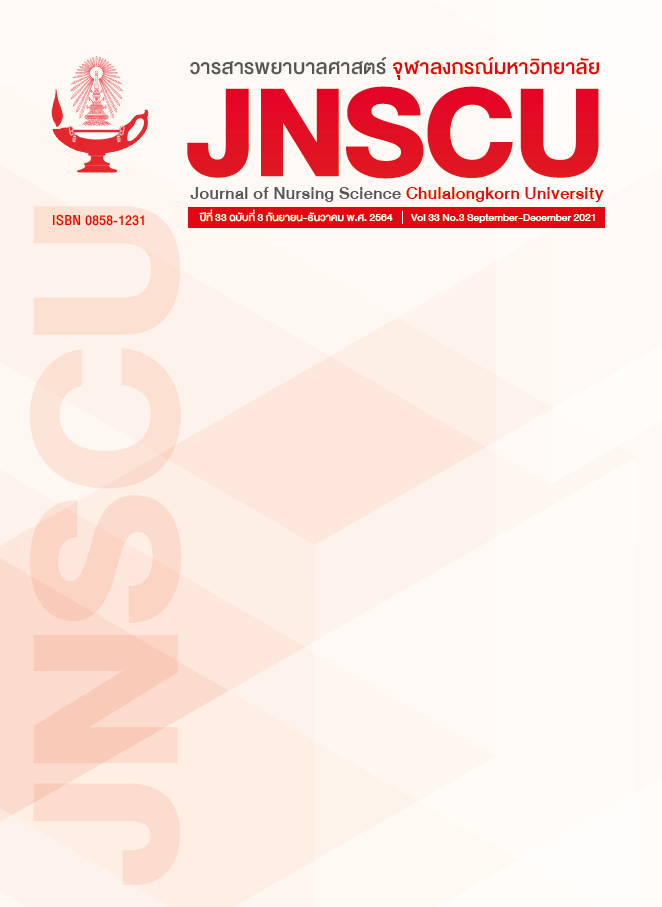ปัจจัยที่มีความสัมพันธ์กับภาวะแขนบวมในผู้ป่วยที่ได้รับการผ่าตัดมะเร็งเต้านมชนิดที่มีการตัดต่อมน้ำเหลือง
คำสำคัญ:
ภาวะแขนบวมจากน้ำเหลืองคั่ง, ภาวะแขนบวมในผู้ป่วยมะเร็งเต้านม, มะเร็งเต้านมบทคัดย่อ
วัตถุประสงค์: เพื่อศึกษาปัจจัยที่มีความสัมพันธ์กับภาวะแขนบวมในผู้ป่วยที่ได้รับการผ่าตัดมะเร็งเต้านมชนิดที่มีการตัดต่อมน้ำเหลือง
รูปแบบการวิจัย: การวิจัยเชิงพรรณนาหาความสัมพันธ์
วิธีดำเนินการวิจัย: กลุ่มตัวอย่าง คือ ผู้ป่วยมะเร็งเต้านมภายหลังได้รับการผ่าตัดมะเร็งเต้านมชนิดที่มีการตัดต่อมน้ำเหลืองมาเป็นระยะเวลา 1 ปีขึ้นไป จำนวน 148 ราย ที่เข้ารับการตรวจรักษา ณ โรงพยาบาลระดับตติยภูมิในเขตบริการสุขภาพที่ 4 จำนวน 3 โรงพยาบาล คัดเลือกด้วยวิธีสุ่มแบบเจาะจงตามเกณฑ์คัดเข้า รวบรวมข้อมูลด้วยแบบสอบถาม 4 ส่วน ประกอบด้วย 1) ข้อมูลส่วนบุคคล 2) อาการที่สัมพันธ์กับภาวะแขนบวม 3) การได้รับข้อมูลเกี่ยวกับภาวะแขนบวม และ 4) พฤติกรรมการลดความเสี่ยงในการเกิดภาวะแขนบวม ซึ่งมีความตรงตามเนื้อหา และค่าสัมประสิทธิ์แอลฟาครอนบาคของแบบสอบถามที่ 2, 3, และ 4 เท่ากับ .88, .82, .88 ตามลำดับ ประเมินภาวะแขนบวมจากการวัดเส้น รอบวงแขนทั้ง 2 ข้าง จำนวน 6 ตำแหน่ง หากมีความแตกต่างของเส้นรอบวงแขนที่ตำแหน่งใดตำแหน่งหนึ่ง > 2 เซนติเมตร ให้ถือว่ามีภาวะแขนบวม วิเคราะห์ข้อมูลโดยสถิติพรรณนา สถิติสหสัมพันธ์พอยท์ไบซีเรียล การทดสอบไคสแควร์ และฟิชเชอร์เอกซ์แซคท์
ผลการวิจัย: กลุ่มตัวอย่างมีอายุเฉลี่ย 59.52 ปี (S.D.=11.22) ส่วนมากเป็นมะเร็งเต้านมระยะที่ 2 (ร้อยละ 43.2) ระยะเวลาหลังผ่าตัดมะเร็งเต้านมเฉลี่ย 4.44 ปี (S.D.=3.58) พบมีภาวะแขนบวมจำนวน 51 ราย (ร้อยละ 34.5) ปัจจัยที่มีความสัมพันธ์กับภาวะแขนบวม ได้แก่ การได้รับรังสีรักษา (2 =15.37, p < 0.001) รูปแบบการผ่าตัด (2=10.28, p <0.05) และพฤติกรรมการลดความเสี่ยงในการเกิดภาวะแขนบวมโดยรวม (rpb = - 0.298, p < 0.001) นอกจากนี้ การรายงานอาการที่สัมพันธ์กับภาวะแขนบวม มีความสัมพันธ์กับภาวะแขนบวมอย่างมีนัยสำคัญทางสถิติ (rpb = 0.577, p < 0.001)
สรุป: รูปแบบการผ่าตัดและการได้รับรังสีรักษาสัมพันธ์กับการเกิดภาวะแขนบวม ดังนั้นควรวางแผนการพยาบาลเพื่อป้องกันภาวะแขนบวมอย่างเหมาะสมในผู้ป่วยกลุ่มนี้ โดยมุ่งเน้นส่งเสริมพฤติกรรมการลดความเสี่ยงในการเกิดภาวะแขนบวม ร่วมกับการประเมินอาการที่สัมพันธ์กับภาวะแขนบวม
เอกสารอ้างอิง
National Cancer Institute. Cancer in Thailand
volume IX 2013-2015. Bangkok: National
Cancer Institute Department of Medical
Services Ministry of Public Health; 2018.
Wanchai A, Armer JM, Stewart BR, Lasinski BB.
Breast cancer-related lymphedema:
A literature review for clinical practice.
International Journal of Nursing Sciences
; 3(2): 202-7.
Ridner SH. Breast cancer lymphedema:
pathophysiology and risk reduction
guidelines. Oncology nursing forum
; 29(9): 1285-93.
Fu MR, Axelrod D, Haber J. Breast-Cancer-
Related Lymphedema: Information,
Symptoms, and Risk-Reduction Behaviors.
Journal of Nursing Scholarship 2008;
(4): 341-8.
Fu MR, Axelrod D, Cleland CM, Qiu Z,
Guth AA, Kleinman R, et al. Symptom
report in detecting breast cancer-related
lymphedema. Breast Cancer: Targets and
Therapy 2015; 7: 345-52. Doi: 10.2147/
BCTT.S87854.
Armer JM, Stewart BR. Post-breast cancer
lymphedema: incidence increases from
to 30 to 60 months. Lymphology
; 43(3): 118-27.
Jung SY, Shin KH, Kim M, Chung SH,
Lee S, Kang HS, et al. Treatment
factors affecting breast cancer-related
lymphedema after systemic chemotherapy
and radiotherapy in stage II/III
breast cancer patients. Breast cancer
research and treatment 2014; 148(1):
-8.
Park JH, Lee WH, Chung HS. Incidence and
risk factors of breast cancer lymphedema.
Journal of Clinical Nursing 2008;
(11): 1450-9.
Geller BM, Vacek PM, O’Brien P, Secker-Walker
RH. Factors associated with arm swelling
after breast cancer surgery. Journal of
women’s health 2003; 12(9): 921-30.
Shahpar H, Atieh A, Maryam A, Fatemeh HS,
Massoome N, Mandana E, et al. Risk
factors of lymph edema in breast cancer
patients. International journal of breast
cancer 2013; 2013: 1-7.
Nguyen TT, Hoskin TL, Habermann EB,
Cheville AL, Boughey JC. Breast cancerrelated
lymphedema risk is related to
multidisciplinary treatment and not
surgery alone: results from a large
cohort study. Annals of surgical oncology
; 24(10): 2972-80.
Can AG, Eksioglu E, Bahtiyarca ZT, Cakcı FA.
Assessment of risk factors in patients
who presented to the outpatient clinic
for breast cancer-related lymphedema.
The journal of breast health 2016; 12(1):
–6. Doi: 10.5152/tjbh.2015.2801.
Ugur S, Arıcı C, Yaprak M, Mescı A, Arıcı GA,
Dolay K, et al. Risk factors of breast
cancer-related lymphedema. Lymphatic
research and biology 2013; 11(2): 72-5.
Armer JM, Radina ME, Porock D, Culbertson
SD. Predicting breast cancer-related
lymphedema using self-reported
symptoms. The Journal of Nursing
Research 2003; 52(6): 370-9.
Thongteratham N. Factors associated with
arm lymphedema in breast cancer
patients after axillary resection [Master’s
Thesis, Nursing Science Program].
Bangkok: Mahidol University; 2005.
Kwan ML, Shen L, Munneke JR, Tam EK,
Partee PN, Andre M, et al. Patient
awareness, and knowledge of breast
cancer-related lymphedema in a large,
integrated health care delivery system.
Breast cancer research and treatment
; 135(2): 591-602.
Fu MR, Chen CM, Haber J, Guth AA,
Axelrod D. The effect of providing
information about lymphedema on the
cognitive and symptom outcomes of
breast cancer survivors. Annals of
surgical oncology 2010; 17(7): 1847-53.
Suka M, Odajima T, Okamoto M, Sumitani M,
Igarashi A, Ishikawa H, et al. Relationship
between health literacy, health
information access, health behavior,
and health status in Japanese people.
Patient education and counseling 2015;
(5): 660-8.
Ridner SH, Montgomery LD, Hepworth JT,
Stewart BR, Armer JM. Comparison of
upper limb volume measurement
techniques and arm symptoms between
healthy volunteers and individuals with
known lymphedema. Lymphology 2007;
(1): 35-46.
ดาวน์โหลด
เผยแพร่แล้ว
ฉบับ
ประเภทบทความ
สัญญาอนุญาต

อนุญาตภายใต้เงื่อนไข Creative Commons Attribution-NonCommercial-NoDerivatives 4.0 International License.
ลิขสิทธิ์ของบทความที่ตีพิมพ์เป็นของวารสารพยาบาลศาสตร์ จุฬาลงกรณ์มหาวิทยาลัย ทั้งฉบับตีพิมพ์เป็นรูปเล่มและเอกสารออนไลน์



